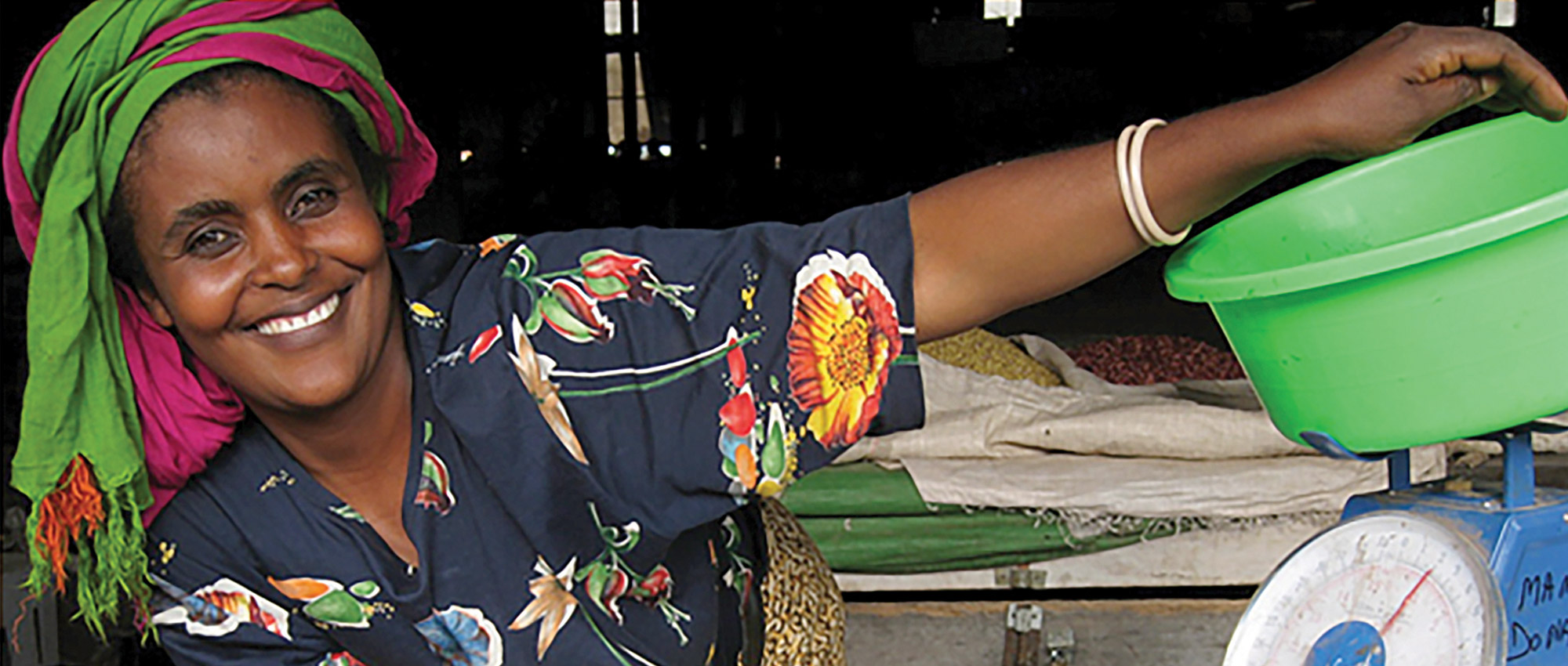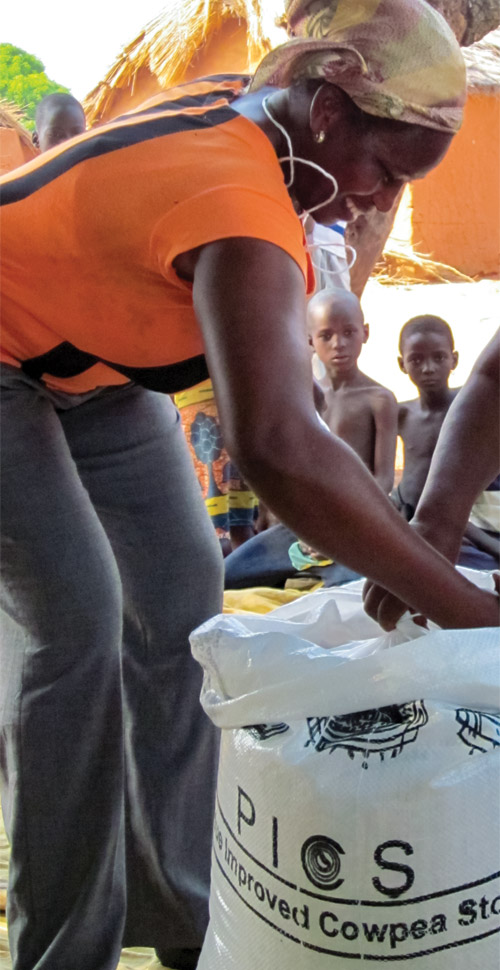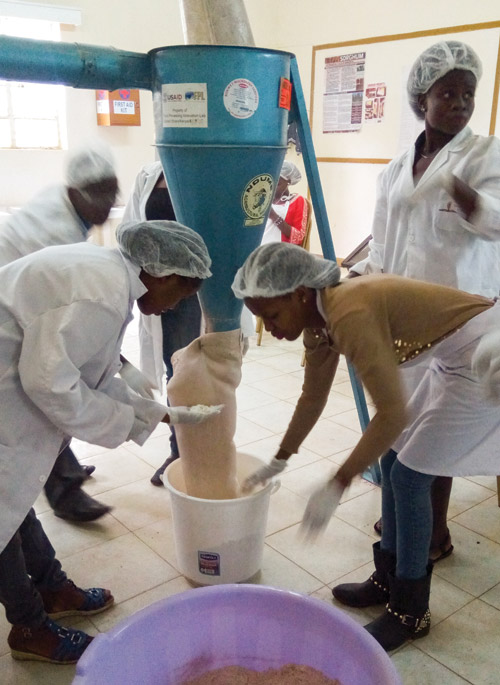
Saving for the Future
It’s impossible to measure the full impact of Madame Astou Gaye Mbacke’s entrepreneurship on the people of Senegal—and it all grew from small golden grains of millet. Her facility processes cereal-based products from grains grown by Senegalese farmers, including signature products of millet grain mixed with mango, baobab, or other local fruits and run through an extruder. The result: precooked pellets that are ground into a fortified flour, the key ingredient of porridge. Thanks to the extruder, the preparation of porridge is reduced from hours to minutes. Just add hot water, and an entire family is fed.
Mbacke’s business is a success due in part to the training she received at a food processing incubation center established by Purdue University in collaboration with the ITA, a food research institute in Senegal. In the Feed the Future Innovation Lab for Food Processing and Post-Harvest Handling, food-processing entrepreneurs have access to food and nutrition technologies, as well as training to help them establish or upgrade their businesses. Mbacke now employs over 100 people in the processing plant and sells the millet flour-based products to a network of over 3,000 women entrepreneurs who distribute them to urban markets. She also sells to government programs that feed hungry and malnourished children. Her work is a reminder that creating an efficient food supply isn’t just what happens in the field, but what happens after harvest.
the takeaway
- Previous research aimed at feeding the globe has focused largely on increasing crop production. Faculty in the Purdue Postharvest Initiative focus on research in developing nations to efficiently dry and store grains and process them as high-quality food products.
- Key innovations include low-cost transportable grain dryers, extrusion technology to create ready-to-eat foods, and fortified food products. In addition, Purdue Improved Crop Storage bags are now used in 29 countries in Africa and Asia.
- Processors use local fruits and vegetables to fortify new food products with key nutrients, helping to promote growth and disease resistance in local populations.
- Women play a key role in agriculture as smallholder farmers and food processors. They pass on the economic benefits, purchasing nutritious foods, medical care, and access to education for their children.
- Learn more about all of the projects in the Purdue Postharvest Initiative and the impact they’re having around the globe.
Historically, increasing crop production was the focus of agricultural research to feed the global population. The increased attention to postharvest loss reduction and processing grains into nutritious, value-added food products is relatively new, says Suzanne Nielsen, professor of food science and coordinator of Purdue’s Postharvest Initiative.
That increased focus is important, because as the Food and Agriculture Organization of the United Nations points out, more than 30 percent of food losses and waste occur after harvest. And since 70 percent of rural households in Sub-Saharan Africa depend on agriculture for their livelihood, according to sources published at the African Development Bank Group, food loss is a critical issue.
Enter the Purdue Postharvest Initiative, launched at the 2016 World Food Prize meeting and featuring interdisciplinary teams of 22 researchers across the College of Agriculture, as well as colleagues from the College of Engineering, the College of Health and Human Sciences, and Purdue’s Center for Global Food Security. Members of the initiative are studying more effective and efficient ways to dry, store, and process food crops using innovative, improved technologies in partnership with agricultural institutions in developing nations.
Protecting the harvest
 To store grain for future use, it must first be dried. But crops left in the field to dry can mold or be attacked by insects and animals. Purdue researchers have designed two types of solar crop dryers, targeting different end users. For an extremely low-cost method of drying grain on site that targets smallholder farmers, Arvind Raman, Robert V. Adams Professor in Mechanical Engineering and associate dean for Global Engineering Programs, and Richard Stroshine, professor of agricultural and biological engineering, designed a 3-foot-by-6-foot solar dryer that costs less than $US100 to build, called the Picosolar crOp Dryer (POD).
To store grain for future use, it must first be dried. But crops left in the field to dry can mold or be attacked by insects and animals. Purdue researchers have designed two types of solar crop dryers, targeting different end users. For an extremely low-cost method of drying grain on site that targets smallholder farmers, Arvind Raman, Robert V. Adams Professor in Mechanical Engineering and associate dean for Global Engineering Programs, and Richard Stroshine, professor of agricultural and biological engineering, designed a 3-foot-by-6-foot solar dryer that costs less than $US100 to build, called the Picosolar crOp Dryer (POD).
Consisting of perforated trays covered with black and clear plastic sheets that absorb the sun’s rays, the POD’s main asset, says Raman, is that farmers can dry grain on site, one storage bag at a time. Added bonuses: A solar panel runs the small electric fans that accelerate drying, and a battery stores excess solar energy to run the fans during cloudy weather and brief rains. In the off-season, the panel can be used for other purposes, such as charging cell phones. Because the PODs are transportable and easy to disassemble and reassemble, farmers can also create small businesses drying crops for others. Plans include the development of local supply chains to assemble dryers in Sub-Saharan Africa.
Klein Ileleji, associate professor of agricultural and biological engineering, designed a multipurpose solar dryer that targets small growers and processors in both developing and developed countries. He recently received a grant to work with small growers in Indiana and Georgia on drying specialty crops. The dryer, equipped with stackable trays that can be used independently, is capable of drying several agricultural commodities such as grains, fruits, vegetables, and fish. It can also serve as a generator to power homes and appliances.

A woman demonstrates how to use the Purdue Improved Crop Storage (PICS) bag in Walewale, Ghana.
Improving grain storage is one early achievement in the college’s postharvest efforts. The Purdue Improved Crop Storage (PICS) bag, a simple, airtight triple-layer bag that preserves grain without insecticides, is now used in 29 countries in Africa and Asia, says Dieudonné Baributsa, associate professor of entomology. He is currently working to develop an inexpensive moisture meter that will assess whether grain is dry enough before it goes into a PICS bag. Baributsa’s next step: focusing on the commercialization and supply chain of these bags in current markets and new regions. “We want to improve the availability of the bags at the farm level by increasing manufacturing capacity and streamlining the distribution network of PICS bags in collaboration with PICS Global, a private company created to consolidate these efforts,” he says.
Partners in the field
Having a partner like Catholic Relief Services (CRS), an organization that has been on the ground for nearly 75 years in many developing nations, also aids Purdue’s success. “The institutional knowledge and local partnerships with governments and other actors are invaluable, as well as the logistical infrastructure, which all combine to make CRS a valuable partner for Purdue,” says David Leege, director of university engagement and research at CRS. For the PICS project alone, CRS has partnered with Purdue in 12 countries. On the flip side, he says, “Purdue brings an interdisciplinary expertise, particularly in agriculture, where our collaboration has been really pronounced.”
That expertise extends to developing nutritious food products that local consumers want to buy—a personal mission for Betty Bugusu, managing director of Purdue’s International Food Technology Center and project director of the Food Processing Lab (FPL), part of the Feed the Future initiative of the U.S. government. As a child on a small farm in western Kenya, Bugusu watched farmers plant high-yielding crops to produce a food surplus that often went to waste.
To prevent that loss, she focuses on developing markets for nutritious food products, including the logistics of delivering processing equipment where it is needed and navigating poor roads and inconsistent electricity supplies. “I am making a difference and giving back to a community where I grew up,” Bugusu says.
Bugusu works with the same food-processing incubation centers established by Purdue that help train entrepreneurs like Mbacke. The centers are often hosted by a government research institution or local university to facilitate the transition from Purdue to local management. These centers focus on women’s associations, training members in food-processing technologies to make high-quality food products using locally grown crops such as mango or baobab to enhance the nutrition of the products.
“We are expanding the incubation centers to serve existing rural markets and improve nutrition by making foods that local consumers want and can purchase,” Bugusu says. “Rural entrepreneurs can also supply urban markets, expanding their market.”

Mamadou Salif Sow, an engineer at the Institut de Technologie Alimentaire in Senegal, tests a small-scale extruder developed at Purdue. The extruder is now in use at incubation centers in Niger and Kenya, as well.
Business opportunities for women also have a positive impact on the wider community, Nielsen says. “If you help a woman, you have helped the entire family. With an income, women will spend their money on their children, paying for them to go to school, or for medicine, medical treatment, and more nutritious food.”
Producing fortified products is a key goal for the Postharvest Initiative, since a lack of nutrients such as zinc, iron, and vitamin A contribute to the risk of stunted growth and low disease resistance. The team is testing products like porridge fortified with nutrient-rich plant sources, such as mango, with a surprise assist from technology originally designed for NASA’s Mars mission. At the Food Processing Training and Incubation Center in Eldoret, Kenya, staff produce fortified flours with the small-scale, low-cost extruder developed by Carlos Corvalan, associate professor of food science; Osvaldo Campanella, professor of agricultural and biological engineering; Martin Okos, professor of agricultural and biological engineering; and Amudhan Ponrajan (PhD ’16, agricultural and biological engineering) to make cereals, snacks, and pasta in space.
Women lead the way
Making new products is a gamble, however, if consumers aren’t enthusiastic about the results. Bruce Hamaker, distinguished professor of food science and Roy L. Whistler Chair, along with colleagues in the FPL, tested products with 200 participants in Kenya, confirming their interest in purchasing fortified millet flour and instant products, including those containing natural nutritional fortification.

Students at the University of Eldoret, Kenya, gain hands-on experience milling cereal grains.
Expanding the market for sorghum and millet products is another goal of the Postharvest Initiative. While maize is the most widely grown staple crop in Sub-Saharan Africa, scientists are encouraging the use of more drought-tolerant indigenous grains in response to the rising temperatures and dwindling water supplies of climate change. To facilitate this growth, Hamaker and collaborators in Africa helped establish urban and rural food processing incubation centers in Niger, Mali, and Kenya, which trained entrepreneurs to create and produce packaged sorghum- and millet-based products.
Farmer and processor buy-in is essential to reducing postharvest crop loss. Since women now outpace men as farm managers and food processors in Africa, the team is reaching out to women. “[Women] are pushing and making the decisions about these food innovations,” Bugusu says.
And women are recruited for training in incubation centers, where they receive skills to establish their own processing businesses. Women like Madame Mbacke serve as vital role models for other women. “She’s an entrepreneur and a philanthropist,” says Nielsen, which is in line with the team’s vision. “We have a real purpose. We can make an impact. That’s the world of people in this Postharvest Initiative.”
Photos provided by Dieudonné Baributsa, Betty Bugusu, Tom Campbell, Violet Mugalavai, Amudhan Ponrajan, and J.C. Rubyogo.